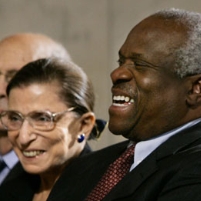Why Has Supreme Court Cut its Work Load in Half?
 Ruth Bader Ginsburg and Clarence Thomas
Ruth Bader Ginsburg and Clarence Thomas
From approximately 8,000 appeals, the U.S. Supreme Court hears about 80 cases a year. This is barely half of what the high court used to hear in the 1980s, when the average yearly workload was 150 cases. Yale’s law school recently conducted a conference exploring the subject of why the Supreme Court hears fewer cases these days. The answers varied considerably. Blame was assessed on newer justices, clerks, Congress, and the Justice Department.
There is something to the argument that the current justices on the court are partially responsible for the smaller caseload, and the difference has nothing to do with ideology. One legal expert reviewed the decisions of justices who were appointed to the bench before 1986 and compared them with those appointed after that year. The analysis showed former Justice Byron White voted to hear an average of 216 cases per term from 1986 to 1992, while his replacement, Ruth Bader Ginsburg, voted to hear 63 cases in 1993. Thurgood Marshall voted to hear 125 on average, while his replacement, Clarence Thomas, voted to hear 72. And William Brennan Jr. voted to hear 129, while the justice who replaced him, David Souter, voted to hear 83.
-Noel Brinkerhoff
The Case of the Plummeting Supreme Court Docket (by Adam Liptak, New York Times)
- Top Stories
- Unusual News
- Where is the Money Going?
- Controversies
- U.S. and the World
- Appointments and Resignations
- Latest News
- Trump to Stop Deportations If…
- Trump Denounces World Series
- What If China Invaded the United States?
- Donald Trump Has a Mental Health Problem and It Has a Name
- Trump Goes on Renaming Frenzy






Comments